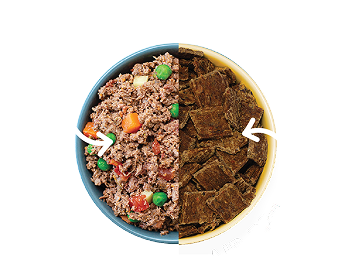
When Do Puppies Stop Growing?
Every puppy parent has wondered, at least once, when their furry bundle of joy will achieve their full-grown size. Watching your puppy grow from a tiny creature to a bigger, more agile version is genuinely one of the marvels of pet parenting.
At A Pup Above, our passion for dogs goes beyond just providing gourmet meals. We understand that knowledge of a puppy’s growth journey is essential for their nutritional needs.
In this article, we aim to unravel the mystery behind your pup's growth while underscoring the importance of nourishing them with the right food every step of the way.
The Basics of Puppy Growth
Your puppy’s growth is complex, influenced by various factors yet driven primarily by their biology. Puppies typically undergo rapid growth during their early weeks and months, followed by a more gradual increase until they mature.
Just like human babies, puppies have a growth curve, and reaching developmental milestones is crucial. The growth pattern involves skeletal development, muscle growth, and the phase where they might seem all paws and ears.
And let's remember the significance of nutrition at each of these stages. Ensuring they get the perfect balance of flavor, nutrition, and palatability, much like the sous-vide dishes from A Pup Above, will support their growth journey.
Factors Influencing Puppy Growth
Breed Size
One of the most significant determinants of a puppy’s growth rate is its breed. Toy breeds, for instance, will mature much faster than large breeds. A Chihuahua might reach its adult size by 10 to 12 months, while a Great Dane could still be growing at 18 months.
Nutrition
Ever wonder why your pup goes crazy for that bone broth-infused dish? It’s more than just the taste. The right nutrition acts as the building blocks for healthy growth.
Providing them with gently cooked, nutritious meals can make all the difference in ensuring they grow at the optimal rate, strong and healthy. Remember, their palate isn’t just seeking flavor; it’s also instinctively seeking nutrition.
Genetics and Parental Lineage
Just as our height might resemble our parents', a puppy's growth potential is heavily influenced by its genetic coding and lineage. So, if you ever have a chance to meet your puppy's parents, it could provide insight into your pup’s future size.
Stages of Puppy Growth
Delving into a puppy's life, their growth can be segmented into distinct stages, each with unique developments.
- Neonatal Period (Birth to Two Weeks): In these first fragile weeks, puppies are almost entirely reliant on their mother's milk, growing rapidly while their eyes and ears remain closed. It's a time of vulnerability, yet foundational for their life ahead.
- Transitional Period (Two to Four Weeks): This stage is marked by the opening of the eyes and ears and the beginning of teeth growth. Their dependency on their mother's milk starts to reduce slightly, but it's still a primary source of nutrition.
- Socialization Period (Four to 12 Weeks): This is arguably one of the most exciting phases for pet parents. Puppies begin to exhibit playful behavior, interact more, and start weaning onto solid foods. It’s vital at this stage to introduce them to flavors and nutrition profiles that they'll need for optimal growth.
- Juvenile Period (Three to Six Months): This stage sees a deceleration in growth but an increase in playful antics and learning. Nutritionally, a gradual transition to more substantial meals becomes essential.
- Adolescence (Six to 18 Months): Depending on the breed, this is when growth plateaus. They are more energetic, often testing boundaries, and their nutritional needs lean more towards maintenance than rapid growth.
Nutritional Needs at Various Stages
Catering to the right nutrition at each growth stage is pivotal. The A Pup Above philosophy prioritizes this:
- Neonatal & Transitional: Mother's milk offers all they need. However, if hand-rearing, opt for vet-recommended milk replacers.
- Socialization: Begin introducing them to high-quality puppy food. The advantage of A Pup Above meals here is the gentleness of sous-vide cooking, ensuring palatability and optimal nutrition without overwhelming their delicate system.
- Juvenile: Their diet should be rich in protein, essential fatty acids, and particular vitamins and minerals. Ensure you're picking the right portion sizes and frequency.
- Adolescence: Gradually switch to adult food varieties. With the slowing of growth, it's vital to monitor weight and ensure they're not overfed. As always, prioritize quality over quantity.
Misconceptions About Puppy Growth
With myriad information sources, myths are bound to emerge. Let’s debunk a few in line with our commitment to clarity and pet health:
- Bigger Paws Mean a Bigger Dog: While sometimes true, it's not a steadfast rule. Genetics play a far more significant role than paw size in determining adult size.
- Human Food Is Always Bad: Not always. Some human-grade foods are not only safe but nutritious for pups. Always consult a vet before introducing new foods.
- Puppies Should Eat As Much As They Want: Overfeeding can lead to obesity and other health issues. It's about balance, not abundance.
How To Determine if Your Puppy Has Stopped Growing
The crescendo of your puppy’s growth journey culminates when they transition into their adult form. But, discerning this transition can be a bit tricky. One of the most evident signs is a slowing growth rate.
If you've noticed that your pup's size has remained consistent over a few months, it's a good indicator that they've likely reached their adult size. Additionally, by six to 18 months, puppies usually begin transitioning into adulthood. This phase is marked by matured behavior, and those classic puppy antics might become less frequent.
It's also crucial not to overlook the importance of regular vet visits during this growth phase. Your vet can provide valuable insights into your pup's development, measuring aspects like bone growth and especially noting the closure of growth plates to determine if the growth has concluded.
Another handy milestone to keep in mind is teeth development. By six months, most puppies will proudly sport their complete set of adult teeth. While the maturity of their dental set doesn't align directly with skeletal growth, it serves as a good indicator of their overall developmental progress.
Embracing the Journey: Nurturing Your Puppy to Adulthood
Navigating the stages of puppy growth is a delightful and educational journey. Their nutritional needs evolve as they transform from tiny furballs to spirited adults. At A Pup Above, we appreciate the nuances of this journey, emphasizing the importance of providing optimal nutrition tailored to each stage.
We strive to be more than just a pet food brand — we're your partners, cheering on as you and your puppy navigate this beautiful journey together. Prioritizing health, flavor, and nutrition, we aim to ensure that every meal they devour is a step towards a healthy, active, and long life.
So, as you cherish the boundless energy, those mischievous antics, and the pure love your puppy offers, remember that understanding their growth journey is crucial. It’s not merely about their physical transformation but ensuring they’re fueled with the best every step of the way.
Sources:
Great Dane | Description, Temperament, Lifespan, & Facts | Britannica
Why Are Puppies Born With Their Eyes and Ears Closed? | Psychology Today
Lactation in the dog: milk composition and intake by puppies | National Library of Medicine
Top Stories

Why Do Dogs Lick Their Paws?

Why Do Dogs Whimper & Make Noises in Their Sleep?

Healthy Vet-Approved Homemade Dog Food Recipes

How To Cook Sweet Potatoes for Dogs






















